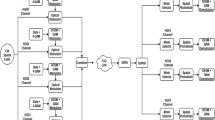Abstract
Free space optical (FSO) communication technology has been identified as a promising, complementary solution to the existing radio frequency (RF) solution because of its support for high speed data transmission. Though FSO has tremendous potential to compete with existing communication technologies, turbulence in atmosphere affects the propagation path of the optical beam and limits its system performance. This paper investigates the impact of turbulent atmosphere on the received optical irradiance which carries an asymmetrically clipped optical OFDM (ACO-OFDM) data signal. The FSO communication system employs intensity modulation/direct detection (IM/DD) scheme. An analytical model is developed to capture the turbulence effect with the assumption that the beam-wander plays a dominant role in determining the intercepted signal irradiance at the receiver aperture. The bit-error rate (BER) of the photo-detected signal is evaluated for weak-, moderate- and strong-turbulent channels assuming that the optical beam has Gaussian distributed profile whose beam width is affected by beam-wander. Numerical simulation results provide an insight into the role of various system parameters on received signal for a desired performance.
Access this chapter
Tax calculation will be finalised at checkout
Purchases are for personal use only
Similar content being viewed by others
References
Ghassemlooy Z, Poopola W, Rajbhandari S (2013) Optical wireless communications system and channel modelling. CRC Press,Taylor and Francis Group with MATLAB. First Edition, 2013, ebook. ISBN: 978-1-4398-5235-4.
Kaushal H, Kaddoum G (2017) Optical communication in space: challenges and mitigation techniques. In: IEEE Communications Surveys & Tutorials
Motlagh AC, Ahmadi V, Ghassemlooy Z, Abedi K (2008) The effect of atmospheric turbulence on the performance of the free space optical communications. IEEE Proceedings
Anbarasi K, Hemanth C, Sangeetha RG (2017) A review on channel models in free space optical communication systems. Optics Laser Technol 97:161–171
Larry CA, Ronald L.P, Hopen CY (2001) Laser beam scintillation with applications. SPIE Optical Engineering Press, Bellingham, Washington
Ratnam J, Mali S (2020) Power-efficiency in asymmetrically-clipped optical OFDM system with truncated-PAPR. In: ICICCT 2019-system reliability, quality control, safety, maintenance and management. Springer Nature Singapore Pte. Ltd. https://doi.org/10.1007/978-981-13-8461-5_79
Prokes A (2009) Modelling of atmospheric turbulence effect on terrestrial FSO link. Radio Eng 8(1)
Kaushal H, Kaddoum G, Jain VK, Kar S (2017) Experimental investigation of optimum beam size for FSO uplink. Optics Commun 400:106–114
Dissanayake SD, Armstrong J (2013) Comparison of ACO-OFDM, DCO-OFDM and ADO-OFDM in IM/DD systems. J Lightwave Technol 31(7)
Jiang D, Yuan Y, Lin Y, Lyu T, Zhu B, Yan Y (2018) Mean irradiance profile of a Gaussian beam under random jitter. Optics Express 26(21):27472
Andrews LC, Phillips RL (1998) Laser Beam Propagation through Random Media. SPIE Press, Bellingham
Reza SA, Arshad MA (2019) Novel method of wireless data transfer through a variable focus lens-induced irradiance modulation of a Gaussian beam. 10.1109/ACCESS.2017.2651804
Author information
Authors and Affiliations
Corresponding author
Editor information
Editors and Affiliations
Rights and permissions
Copyright information
© 2021 The Editor(s) (if applicable) and The Author(s), under exclusive license to Springer Nature Singapore Pte Ltd.
About this paper
Cite this paper
Mali, S., Ratnam, J. (2021). Performance of a Free Space Optical Link with ACO-OFDM-Based Signal Transmission Under Beam-Wander-Dominated Atmospheric Turbulence. In: Sharma, R., Mishra, M., Nayak, J., Naik, B., Pelusi, D. (eds) Green Technology for Smart City and Society. Lecture Notes in Networks and Systems, vol 151. Springer, Singapore. https://doi.org/10.1007/978-981-15-8218-9_20
Download citation
DOI: https://doi.org/10.1007/978-981-15-8218-9_20
Published:
Publisher Name: Springer, Singapore
Print ISBN: 978-981-15-8217-2
Online ISBN: 978-981-15-8218-9
eBook Packages: Intelligent Technologies and RoboticsIntelligent Technologies and Robotics (R0)




